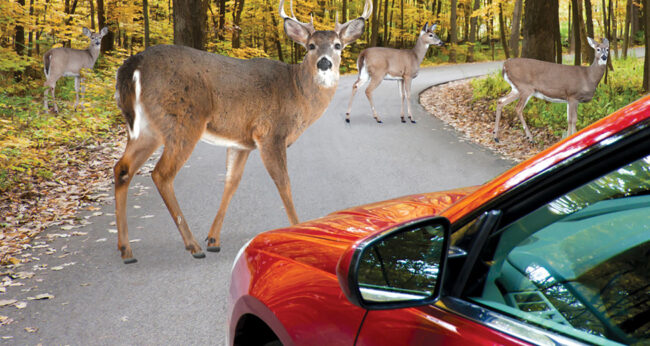Article
Deer-vehicle Collisions

TAKE STEPS TO REDUCE INCIDENTS
Minnesota drivers are involved in thousands of deer-vehicle collisions each year. In 2020, these collisions injured 178 people and killed four.* With approximately 9,000 vehicles covered by MCIT and employees operating personal vehicles for work purposes, MCIT members have a significant exposure to these types of collisions.
In fact, in 2020 MCIT responded to more than 177 deer-vehicle collisions, costing an average of $6,276 in property damage per claim.
The unpredictable nature of deer makes these collisions difficult to prevent, but there are measures drivers can take to reduce the number of incidents or minimize the damage when they occur.
Awareness Is Key
Drivers must take the danger of striking a deer with a vehicle seriously. The average white-tailed deer stands 6 to 7.75 feet high and weighs 110 to 300 pounds. Drivers can expect significant damage to their vehicles and potentially suffer injuries if they hit a deer at high speeds.
Being aware of general deer behavior can help drivers avoid some accidents. Deer and vehicle collisions occur most frequently in rural areas in the fall and spring, and during dusk and dawn. Nearly half of all deer-vehicle collisions occur in the October to December mating season when deer are especially active and during hunting season when more people enter their habitats. Collisions increase again in spring when grass starts to grow in roadway ditches.
Drivers should consider the following to avoid striking a deer:
-
- Be alert for deer at all times and especially during dusk and dawn and during the fall and spring.
-
- Drive within the vehicle’s headlight distance.
-
- Reduce speed to allow for more reaction time when spotting deer.
-
- Expect other deer to follow if one appears, because these animals herd.
-
- Search and scan the roadway and roadside, paying close attention to areas with deer crossing warning signs.
-
- Keep the windshield clean, buckle up, stay sober.
-
- Keep the vehicle’s headlights properly adjusted, and use the high beams where possible.
-
- Do not rely on car-mounted deer whistles. There is limited evidence of their effectiveness and their use can create a false sense of security among drivers.
Minimize an Unavoidable Collision
If hitting a deer is imminent, drivers are encouraged to follow these best practices:
-
- Do not swerve. This could lead to losing control of the vehicle and placing the driver and occupants in the path of oncoming traffic or striking an object on the side of the road.
-
- Brake firmly.
-
- Hold the steering wheel with both hands.
-
- Come to a controlled stop.
-
- Steer the vehicle well off the roadway.
-
- Turn on the vehicle’s hazard flashers.
-
- Be aware of other traffic when leaving the car.
-
- Report the collision to the nearest law enforcement agency.
-
- Follow the established personal insurance or employer reporting process.
Unless it is their job, employees should be discouraged from attempting to move a deer from the roadway. Performing such a task can be dangerous because of traffic, the weight of the deer and awkward lifting required to move the animal.
Resources for Members
MCIT has a number of resources to help members improve their employees’ driving skills to reduce collisions:
-
- Seat belt use stickers: Order by contacting info@mcit.org
Members may contact MCIT at 1.866.547.6516 or info@mcit.org for more information about these items.
Topics



